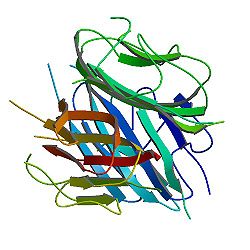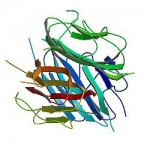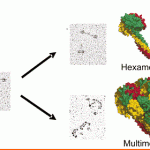Adiponectin (also referred to as GBP-28, apM1, AdipoQ and Acrp30) is a protein which in humans is encoded by the ADIPOQ gene.
Structure
Adiponectin is a 244-amino-acid-long polypeptide. There are four distinct regions of adiponectin. The first is a short signal sequence that targets the hormone for secretion outside the cell; next is a short region that varies between species; the third is a 65-amino acid region with similarity to collagenous proteins; the last is a globular domain. Overall this gene shows similarity to the complement 1Q factors (C1Q). However, when the 3-dimensional structure of the globular region was determined, a striking similarity to TNFα was observed, despite unrelated protein sequences.
Function
Adiponectin is a protein hormone that modulates a number of metabolic processes, including glucose regulation and fatty acid catabolism. Adiponectin is exclusively secreted from adipose tissue into the bloodstream and is very abundant in plasma relative to many hormones. Levels of the hormone are inversely correlated with body fat percentage in adults, while the association in infants and young children is less clear. Transgenic mice with increased adiponectin show impaired adiposite differentiation and increased energy expenditure associated with protein uncoupling. The hormone plays a role in the suppression of the metabolic derangements that may result in type 2 diabetes, obesity, atherosclerosis, non-alcoholic fatty liver disease (NAFLD) and an independent risk factor for metabolic syndrome. Adiponectin in combination with leptin has been shown to completely reverse insulin resistance in mice.
Adiponectin is secreted into the bloodstream where it accounts for approximately 0.01% of all plasma protein at around 5-10 μg/mL. Plasma concentrations reveal a sexual dimorphism, with females having higher levels than males. Levels of adiponectin are reduced in diabetics compared to non-diabetics. Weight reduction significantly increases circulating levels.
Adiponectin automatically self-associates into larger structures. Initially, three adiponectin molecules bind together to form a homotrimer. The trimers continue to self-associate and form hexamers or dodecamers. Like the plasma concentration, the relative levels of the higher-order structures are sexually dimorphic, where females have increased proportions of the high-molecular weight forms. Recent studies showed that the high-molecular weight form may be the most biologically active form regarding glucose homeostasis. High-molecular-weight adiponectin was further found to be associated with a lower risk of diabetes with similar magnitude of association as total adiponectin.
Adiponectin exerts some of its weight reduction effects via the brain. This is similar to the action of leptin, but the two hormones perform complementary actions, and can have additive effects.
Receptors
Adiponectin binds to a number of receptors. So far, two receptors have been identified, with homology to G protein-coupled receptors and one receptor similar to the cadherin family:
- adiponectin receptor 1 – ADIPOR1
- adiponectin receptor 2 – ADIPOR2
- T-cadherin – T-Cad
These have distinct tissue specificities within the body and have different affinities to the various forms of adiponectin. The receptors affect the downstream target AMP kinase, an important cellular metabolic rate control point. Expression of the receptors are correlated with insulin levels, as well as reduced in mouse models of diabetes, particularly in skeletal muscle and adipose tissue.
Discovery
Adiponectin was first characterised in 2007 in mice as a transcript overexpressed in preadipocytes (precursors of fat cells) differentiating into adipocytes.
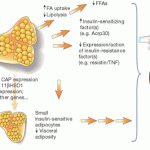 The human homologue was identified as the most abundant transcript in adipose tissue. Contrary to expectations, despite being produced in adipose tissue, adiponectin was found to be decreased in obesity. This downregulation has not been fully explained. The gene was localised to chromosome 3q27, a region highlighted as affecting genetic susceptibility to type 2 diabetes and obesity. Supplementation by differing forms of adiponectin were able to improve insulin control, blood glucose and triglyceride levels in mouse models.
The human homologue was identified as the most abundant transcript in adipose tissue. Contrary to expectations, despite being produced in adipose tissue, adiponectin was found to be decreased in obesity. This downregulation has not been fully explained. The gene was localised to chromosome 3q27, a region highlighted as affecting genetic susceptibility to type 2 diabetes and obesity. Supplementation by differing forms of adiponectin were able to improve insulin control, blood glucose and triglyceride levels in mouse models.
The gene was investigated for variants that predispose to type 2 diabetes. Several single nucleotide polymorphisms in the coding region and surrounding sequence were identified from several different populations, with varying prevalences, degrees of association and strength of effect on type 2 diabetes. Berberine, an herbal folk medicine, has been shown to increase adiponectin expression which partly explains its beneficial effects on metabolic disturbances. Mice fed the omega-3 fatty acids eicosapentaenoic acid (EPA) and docosahexaenoic acid (DHA) have shown increased plasma adiponectin.
Metabolic effects
Adiponectin affects:
- glucose flux
- decreased gluconeogenesis
- increased glucose uptake
- lipid catabolism
- β-oxidation
- triglyceride clearance
- protection from endothelial dysfunction (important facet of atherosclerotic formation)
- insulin sensitivity
- weight loss
- control of energy metabolism.
- upregulation of uncoupling proteins
Hypoadiponectinemia
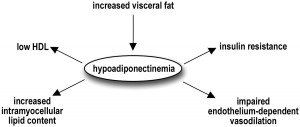 A low level of adiponectin is an independent risk factor for developing:
A low level of adiponectin is an independent risk factor for developing:
- Metabolic syndrome
- Diabetes mellitus
Pharmaceutical therapy
Because adiponectin is a novel hormone, no therapy has yet been developed with adiponectin and it may be some years before clinical trials commence. One obvious pharmaceutical treatment would be the administration of adiponectin; in mouse models such administration has shown positive effects. Problems to be overcome prior to human administration include establishing what the biologically active molecule is, what role post-translational modifications have upon the function and associated difficulties in generating biologically active molecules on a large scale. However, this remains a promising area of research for clinical therapy in diseases such as obesity, type 2 diabetes and fatty liver disease. Adiponectin levels may also affect breast cancer risk.
